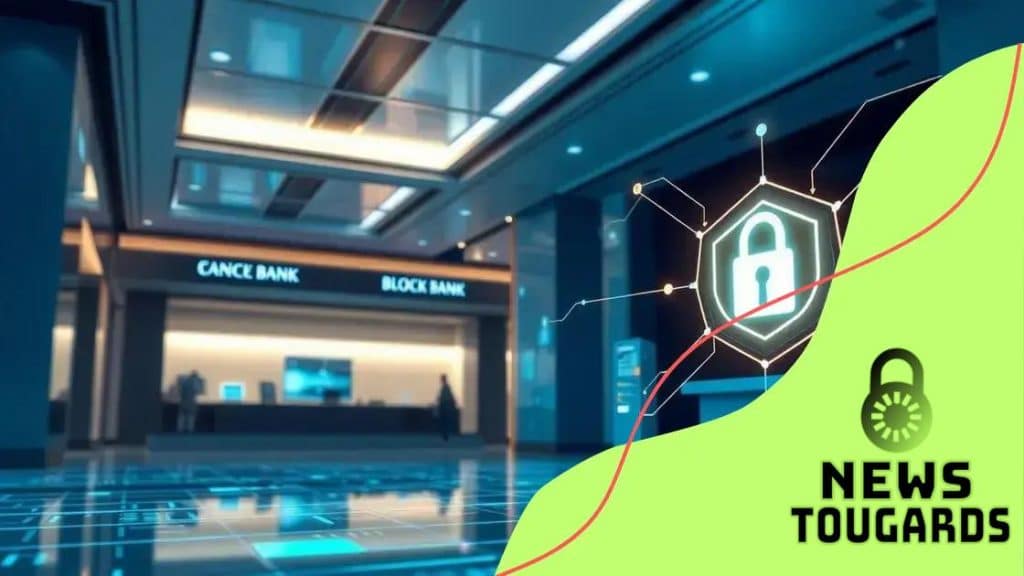How blockchain is disrupting traditional banking systems

How blockchain is disrupting traditional banking systems by enhancing transaction efficiency, reducing costs, and increasing security through decentralized finance and transparent practices.
How blockchain is disrupting traditional banking systems might just change how we think about money. Imagine faster transactions, lower fees, and enhanced security—curious about how this shift could affect your financial life?
Understanding blockchain technology
Understanding blockchain technology is essential for grasping how it is transforming various industries, especially banking. This technology creates a secure and transparent way of recording transactions, enhancing trust among participants.
The core idea of blockchain is that it is a decentralized ledger. This means that no single entity has control over the entire data, making it inherently resistant to fraud. Instead of being stored in one location, the data is distributed across numerous computers, known as nodes. This distribution leads to higher security and reliability.
Key Features of Blockchain
Let’s look at the primary features that make blockchain unique:
- Decentralization: Eliminates the need for intermediaries, allowing peer-to-peer interactions.
- Transparency: Transactions are accessible to all users, ensuring clarity in operations.
- Security: Uses cryptographic principles for secure data exchange, making it difficult to alter past entries.
- Immutability: Once recorded, the data cannot be changed, independent of user influence.
As we dig deeper, it’s crucial to understand how these features work together. Each transaction is linked to the previous one, forming a chain. This makes it almost impossible to change any single record without altering all subsequent records, thereby increasing security.
Moreover, innovation is evident in how blockchain technology addresses limitations faced by traditional banking systems. By providing faster processing times for transactions and lower fees, blockchain contributes to a more efficient financial ecosystem.
Blockchain in Action
To illustrate the practical applications, consider cryptocurrencies. These digital currencies utilize blockchain to facilitate secure transactions without needing banks. This not only increases financial inclusion but also provides users with greater control over their assets.
Additionally, blockchain has potential beyond currencies. Supply chains, smart contracts, and identity verification are becoming increasingly reliant on this technology. Each of these areas benefits from the inherent qualities of blockchain, leading to more efficient processes and improved security.
In summary, understanding blockchain technology allows us to appreciate its impact on banking and beyond. By replacing outdated systems with streamlined processes, it paves the road for a future where efficiency and security work hand in hand.
Key benefits of blockchain for banking
The key benefits of blockchain for banking are transforming how financial institutions operate. By leveraging this technology, banks can enhance their services and provide better security to customers.
One of the most significant benefits is improved efficiency. Traditional banking methods often involve lengthy processes with multiple intermediaries. With blockchain, transactions can be completed much faster and with fewer steps because they are automated through smart contracts.
Advantages of Using Blockchain
Here are some key advantages that banks can gain by integrating blockchain technology:
- Cost Reduction: Eliminating middlemen reduces transaction fees and operational costs.
- Enhanced Security: Blockchain uses advanced cryptography, making data tampering nearly impossible.
- Increased Transparency: All transactions are visible on the blockchain, which builds trust among users.
- Real-Time Processing: Transactions occur instantly, allowing for better revenue flows.
Furthermore, blockchain can reduce fraud risks. Each transaction is recorded in a secure and immutable way, which provides a clear audit trail. This accountability ensures that all actions can be verified by all parties, which protects against malicious activities.
Impact on Customer Experience
For customers, the benefits of blockchain extend beyond just security. They also experience faster services and greater control over their funds. In addition, with made easier access to financial services, unbanked populations can gain entry into the financial system.
Moreover, decentralized finance (DeFi) platforms are emerging, offering direct lending and borrowing without the need for banks as intermediaries. This shift allows customers to interact directly with the financial ecosystem, further enhancing their experience.
In conclusion, the integration of blockchain technology in banking introduces numerous benefits, leading to a secure, efficient, and customer-centric financial future.
Challenges in adopting blockchain

While the potential of blockchain technology in banking is immense, there are also several challenges in adopting blockchain. Understanding these hurdles is crucial for financial institutions looking to implement this technology.
One major challenge is the regulatory landscape. Since blockchain is relatively new, many regulations surrounding its use are still being developed. This uncertainty can deter banks from fully embracing the technology, as they fear potential legal and compliance issues.
Technical Challenges
Technical hurdles also play a significant role in adoption. The complexity of integrating blockchain systems with existing banking infrastructure can be daunting. Banks need to invest in training staff and upgrading their technology.
- Interoperability: Different blockchain platforms may not work well together, leading to complications in data sharing.
- Scalability: Many blockchain networks face challenges in handling high transaction volumes, which is critical for banks.
- Security Issues: While blockchain is generally secure, vulnerabilities in smart contracts or network attacks can pose risks.
Another significant concern is customer perception. Many users remain unaware of how blockchain works and may be skeptical of new technologies. Banks need to educate their customers about the benefits and security offered by blockchain to build trust and increase adoption.
Cost Implications
The costs associated with implementing blockchain technology can also be a barrier. Initial investments in technology upgrades and training can be substantial. Banks may struggle to justify these expenses without a clear, immediate return on investment.
In addition to startup costs, ongoing maintenance and potential updates require continuous funding. This financial uncertainty can make banks hesitant to take the leap into blockchain solutions.
Despite these challenges, many believe that the long-term benefits of blockchain technology for banking will outweigh the initial hurdles. Addressing these issues effectively can lead to more secure, efficient, and innovative banking solutions.
Comparing blockchain and traditional banking
Comparing blockchain and traditional banking reveals significant differences that can impact how financial services are provided. Traditional banking systems have operated for centuries, while blockchain technology is relatively new, introducing innovations that challenge the conventional methods.
One of the main differences lies in centralization. Traditional banks are centralized entities, meaning they control transactions and maintain records. This centralization can lead to inefficiencies and increased costs. In contrast, blockchain operates on a decentralized network, allowing users to engage in peer-to-peer transactions without needing an intermediary.
Speed and Efficiency
When it comes to transaction speed, blockchain often excels. Traditional banks may take several days to process transactions, especially international ones, due to various checks and approvals. On the other hand, transactions made through blockchain can be settled in a matter of minutes, as they are confirmed by multiple nodes in the network almost instantly.
- Transaction Fees: Blockchain transactions typically have lower fees than traditional banking, where fees accumulate from multiple services.
- Security: Blockchain’s encryption and transparency make it less susceptible to fraud compared to traditional banking systems, which can be targeted by cyberattacks.
- Accessibility: With blockchain, anyone with internet access can participate without going through a bank.
Moreover, blockchain technology provides greater transparency. Every transaction is recorded on a public ledger, making it difficult to alter or hide data. In traditional banking, data may not be as accessible, leading to trust issues among customers.
Customer Experience
Customer experience also differs significantly. Traditional banks often require multiple visits and extensive paperwork for services like loans. In contrast, blockchain simplifies many processes, allowing for quicker access to funds through decentralized finance platforms.
However, despite these advantages, traditional banking systems have established trust and reliability over the years. Customers may feel safer using familiar banking institutions rather than adopting new technologies like blockchain.
In conclusion, comparing blockchain with traditional banking shows stark contrasts in their operational methods. While blockchain provides innovative solutions that enhance speed, reduce costs, and provide transparency, traditional banking continues to play a vital role in the financial landscape.
Future of blockchain in financial systems
The future of blockchain in financial systems holds great promise, as it continues to evolve and reshape the way we handle transactions and financial data. As more institutions recognize its potential, we can expect to see significant changes across the industry.
To begin with, we will likely witness an increase in the adoption of blockchain technology by traditional banks. Many banks are already investing in research and pilot programs to integrate blockchain solutions into their operations. This shift aims to enhance efficiency and security, reduce transaction costs, and streamline processes.
Decentralized Finance (DeFi)
One of the standout trends is the growth of decentralized finance (DeFi). DeFi platforms allow users to access financial services without relying on traditional banking intermediaries. These platforms enable lending, borrowing, and trading assets, all facilitated by smart contracts on the blockchain.
- Financial Inclusion: DeFi offers services to unbanked populations, expanding access to financial products.
- Reduced Costs: By eliminating intermediaries, users can save on fees associated with traditional banking.
- Global Reach: Anyone with internet access can participate, leading to a more connected financial market.
Furthermore, the integration of blockchain technology with emerging technologies like artificial intelligence (AI) and the Internet of Things (IoT) is set to create innovative solutions. For instance, using IoT devices to collect data can improve transaction tracking and verify the authenticity of products on the blockchain.
Regulatory Developments
As blockchain becomes more mainstream, regulatory frameworks are likely to evolve. Governments are exploring ways to ensure that blockchain applications comply with existing laws while also fostering innovation. A clear regulatory environment can offer consumers more protection while encouraging technological advancements.
Finally, as societal tolerance for data breaches and privacy violations decreases, blockchain technology offers an avenue for increased data security and privacy. The inherent transparency and immutability of blockchain can help build trust between consumers and financial institutions.
In summary, the future of blockchain in financial systems is poised for growth and transformation as it addresses traditional banking limitations. By embracing this technology, financial institutions can enhance efficiency, improve security, and ultimately change the way we interact with money.
FAQ – Frequently Asked Questions about Blockchain in Financial Systems
What is blockchain technology?
Blockchain is a decentralized digital ledger that records transactions across many computers, ensuring security and transparency.
How can blockchain improve traditional banking?
Blockchain can enhance efficiency, reduce transaction costs, and provide greater security in financial operations.
What is decentralized finance (DeFi)?
DeFi allows users to access financial services without relying on traditional banks, utilizing blockchain technology for transactions.
What challenges does blockchain face in banking?
Challenges include regulatory uncertainty, integration with existing systems, and the need for consumer education on new technologies.





